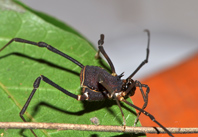Abstract
Hoplitis (Hoplitis) galichicae spec. nov., a new European osmiine bee species belonging to the Hoplitis adunca species group (Osmiini) is described and diagnosed. It is currently known only from the Galichica mountain range in southwestern Macedonia. Analysis of pollen contained in the metasomal scopae revealed that all females of the type series collected pollen on the flowers of Sedum (Crassulaceae), which is unexpected as most other members of the Hoplitis adunca species group are oligolectic or mesolectic on flowers of Boraginaceae and/or Fabaceae. An identification key including all European representatives of the Hoplitis adunca species group is given.
References
Cane, J.H. & Sipes, S. (2006) Characterizing floral specialization by bees: analytical methods and a revised lexicon for oligolecty. In: Waser, N.M. & Ollerton, J. (Eds.), Plant-pollinator interactions from specialization to generalization. University of Chicago Press, Chicago, pp. 99–122.
Michener, C.D. (2007) The bees of the world. 2nd Edition. Johns Hopkins University Press, Baltimore and London, 953 pp.
Müller, A. (2006) Unusual host plant of Hoplitis pici, a bee with hooked bristles on its mouthparts (Hymenoptera: Megachilidae: Osmiini). European Journal of Entomology, 103, 497–500.
http://dx.doi.org/10.14411/eje.2006.064Müller, A. (2012) New European bee species of the tribe Osmiini (Hymenoptera: Apoidea: Megachilidae). Zootaxa, 3355, 29–50.
Müller, A. (2015) Palaearctic osmiine bees - systematics and biology of a fascinating group of solitary bees. ETH Zürich. Available from: http://blogs.ethz.ch/osmiini (accessed 20 November 2015)
Müller, A. & Kuhlmann, M. (2008) Pollen hosts of western palaearctic bees of the genus Colletes (Colletidae) - the Asteraceae paradox. Biological Journal of the Linnean Society, 95, 719–733.
http://dx.doi.org/10.1111/j.1095-8312.2008.01113.xSedivy, C., Dorn, S. & Müller, A. (2013a) Evolution of nesting behaviour and cleptoparasitism in a selected group of osmiine bees (Megachilidae). Biological Journal of the Linnean Society, 108, 349–360.
http://dx.doi.org/10.1111/j.1095-8312.2012.02024.xSedivy, C., Dorn, S., Widmer, A. & Müller, A. (2013b) Host range evolution in a selected group of solitary bees: the Boraginaceae-Fabaceae paradox. Biological Journal of the Linnean Society, 108, 35–54.
http://dx.doi.org/10.1111/j.1095-8312.2012.02013.x

